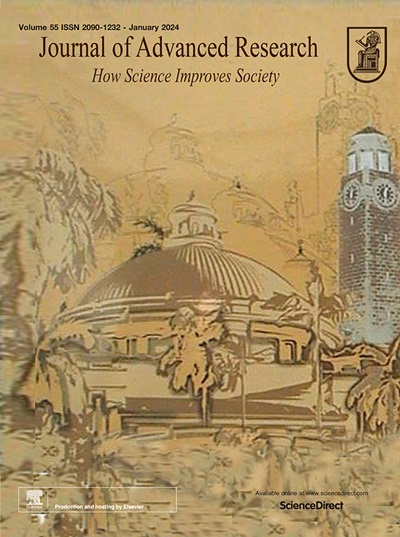丁酸梭菌及其代谢物通过miR-146a调控巨噬细胞极化,拮抗痛风性关节炎
IF 11.4
1区 综合性期刊
Q1 MULTIDISCIPLINARY SCIENCES
引用次数: 0
摘要
肠道菌群调节最近被确定为探索痛风管理的新治疗策略的前瞻性途径。然而,单一特定菌株或细菌代谢物对痛风干预的应用很少被探索,其潜在的调节机制仍然难以捉摸。目的探讨丁酸梭菌和丁酸梭菌在痛风性关节炎治疗中的潜在作用及其分子机制。方法建立痛风性关节炎小鼠Uox-KO模型,分析其肠道菌群组成。补充丁酸梭菌和丁酸梭菌以评估功能恢复和肠道内稳态。纳米链分析鉴定了miRNA变异。GC/MS检测丁酸水平,qPCR检测丁酸生成酶和细菌的丰度。流式细胞术分析巨噬细胞极化,ELISA检测促炎细胞因子的产生。转染Agomir和antagomir,采用双荧光素酶报告试验验证miRNA靶标结合。通过siRNA和抢救实验验证SOCS7在巨噬细胞极化中的作用。此外,为了验证痛风性关节炎的分子机制,我们还召集了一组痛风性关节炎患者。我们的研究结果表明,由于产生丁酸盐的细菌缺乏导致丁酸盐水平降低,导致miR-146a表达异常。这反过来又诱导巨噬细胞极化失衡和痛风性关节炎的发病。丁酸梭菌和丁酸梭菌通过恢复肠道稳态、调节miR-146a表达和扭曲巨噬细胞极化显示出相当大的抗炎功效。SOCS7/JAK2-STAT3信号通路被认为是miR-146a诱导巨噬细胞极化偏斜的关键介质。结论本研究丰富了对痛风性关节炎巨噬细胞极化的调控机制的认识,强调了益生菌及其代谢物在痛风临床治疗中的潜在应用。本文章由计算机程序翻译,如有差异,请以英文原文为准。

Clostridium butyricum and its metabolites regulate macrophage polarization through miR-146a to antagonize gouty arthritis
Introduction
Gut microbiota modulation has recently been identified as a prospective avenue for the exploration of novel therapeutic strategies for the management of gout. Nevertheless, the application of a single specific strain or bacterial metabolite for gout intervention has rarely been explored and the underlying regulatory mechanism remains elusive.Objectives
To ascertain the potential role and the molecular mechanism of Clostridium butyricum and butyrate in the management of gouty arthritis.Methods
A Uox-KO mouse model of gouty arthritis was developed and the composition of the gut microbiota was analyzed. Clostridium butyricum and butyrate were supplemented to assess functional recovery and intestinal homeostasis. NanoString analysis identified miRNA variations. GC/MS measured butyric acid levels and qPCR detected the abundance of butyrate-producing enzymes and bacteria. Flow cytometry analyzed macrophage polarization and ELISA measured pro-inflammatory cytokine production. Agomir and antagomir were transfected and dual-luciferase reporter assay was adapted for validation of miRNA target binding. siRNA and rescue experiments were performed to validate the role of SOCS7 in macrophage polarization. In addition, a cohort of patients with gouty arthritis were assembled for the purpose of validating the molecular mechanism.Results
The results of our study demonstrated that a reduction of butyrate levels, resulting from a deficiency of butyrate-producing bacteria, leads to aberrant miR-146a expression. This, in turn, induces an imbalance in macrophage polarization and the onset of gouty arthritis. The administration of Clostridium butyricum and butyrate demonstrated considerable anti-inflammatory efficacy by restoring intestinal homeostasis, modulating miR-146a expression, and skewing macrophage polarization. The SOCS7/JAK2-STAT3 signaling pathway was identified as a pivotal mediator in the skewing of macrophage polarization induced by miR-146a.Conclusion
Our findings enrich the understanding of the regulatory mechanisms underlying macrophage polarization in gouty arthritis and highlight the potential applications of probiotics and their metabolites in clinical gout treatment.求助全文
通过发布文献求助,成功后即可免费获取论文全文。
去求助
来源期刊

Journal of Advanced Research
Multidisciplinary-Multidisciplinary
CiteScore
21.60
自引率
0.90%
发文量
280
审稿时长
12 weeks
期刊介绍:
Journal of Advanced Research (J. Adv. Res.) is an applied/natural sciences, peer-reviewed journal that focuses on interdisciplinary research. The journal aims to contribute to applied research and knowledge worldwide through the publication of original and high-quality research articles in the fields of Medicine, Pharmaceutical Sciences, Dentistry, Physical Therapy, Veterinary Medicine, and Basic and Biological Sciences.
The following abstracting and indexing services cover the Journal of Advanced Research: PubMed/Medline, Essential Science Indicators, Web of Science, Scopus, PubMed Central, PubMed, Science Citation Index Expanded, Directory of Open Access Journals (DOAJ), and INSPEC.
 求助内容:
求助内容: 应助结果提醒方式:
应助结果提醒方式:


